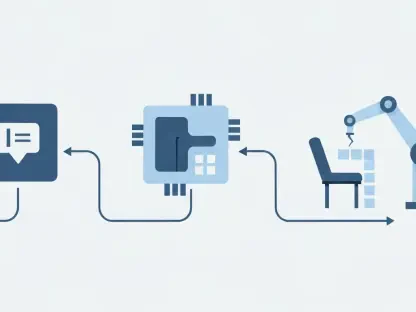Oscar Vail is a recognized technology expert known for his pioneering work in emerging fields like quantum computing and robotics. With a career that consistently pushes boundaries, Oscar provides insights into how technological advancements influence broader sectors, including commercial real estate. Today, he shares his perspectives on recent developments at Tech Corners in Sunnyvale and the impact they have on the market.
Can you elaborate on the significance of Walmart Inc.’s recent lease at Tech Corners in Sunnyvale?
The significance of Walmart’s lease at Tech Corners is multifaceted; it’s not just about occupying space. This move underscores Walmart’s commitment to establishing a substantive presence in Silicon Valley, which is crucial given the tech-driven nature of today’s retail world. This lease also marks an intermediary between two eras – the innovation in retail supported by a robust tech infrastructure and the traditional in-store experience. The deal highlights the strategic value of being located within a tech-hub like Sunnyvale for a retail giant looking to expand its e-commerce capabilities.
How does this lease compare to other recent leases in Silicon Valley, such as the Zscaler lease?
When you look at the Walmart lease compared to something like the Zscaler lease, Walmart’s stands out as the largest since 2023. It’s a testament to the size, scale, and ambition of Walmart’s strategic plan in the valley. While Zscaler undoubtedly represents notable activity within the cybersecurity sector, Walmart’s lease signifies a broader market trend toward hybrid spaces that support diverse tech-centric facets, from cybersecurity to e-commerce innovation.
Could you describe the role Newmark played in the negotiation process for this lease?
Newmark’s role in this negotiation was pivotal. They represented the owner, Jay Paul Company, and ensured that the lease met the mutual goals of both parties. With the expertise of figures like Phil Mahoney and Mike Saign, Newmark steered the negotiation to a constructive conclusion, leveraging their profound understanding of Silicon Valley’s market dynamics and the strategic interests of large tech tenants.
What were some challenges, if any, during the negotiation process?
Negotiations like these often face challenges such as aligning the interests of a tenant like Walmart with the facilities offered by Tech Corners. Although not explicitly detailed, likely hurdles could have included discussions on lease terms reflective of long-term tech industry trends, ensuring the site could accommodate Walmart’s future growth projections, and aligning on renovations or customizations specific to Walmart’s operational needs.
Why do you think Tech Corners continues to attract big names like Walmart Inc. despite the challenging real estate market?
Tech Corners attracts big names largely due to its strategic location and the appeal of its comprehensive tech ecosystem. Coupled with its recent renovations, it offers an attractive, modern, and flexible environment that big companies look for. Even in a challenging market, the availability of a plug-and-play setup in such a sought-after area makes it a premier choice for enterprises needing a scalable home base.
Can you explain the benefits that the recent $30-million renovation brought to the Tech Corners campus?
The extensive $30-million renovation at Tech Corners greatly enhanced its infrastructure and aesthetic appeal. Upgrades likely included state-of-the-art facilities that meet today’s tech needs, improved energy efficiency, and enhanced communal spaces. This redevelopment transformed Tech Corners into a more dynamic and appealing campus, capable of supporting high-volume and diverse business operations.
How does this renovation enhance the campus’s appeal to tenants?
The renovation elevates Tech Corners’ appeal by creating a modern, user-friendly environment tailored to current business trends. It likely includes updated technological infrastructure, which is critical for tech-driven companies. The enhanced amenities contribute to a vibrant workplace culture, which is essential for employee satisfaction and retention, adding significant value for tenants.
What specific features make Tech Corners a “plug-and-play” environment, as mentioned?
Tech Corners is described as “plug-and-play” because it’s designed to offer companies the ability to swiftly launch operations without significant preparatory renovation or infrastructure installation. Likely features include high-speed internet access, integrated office technology systems, and adaptable office spaces designed to cater to various company sizes and operational needs right from the start.
In what ways is Tech Corners transit-served, and why is that important for tenants?
Being transit-served is a crucial asset, and Tech Corners benefits from proximity to major transit routes, likely including local bus services and easy access to freeways or trains. This connectivity is vital for tenants, as it enhances employee commutes, facilitates business travel, and contributes to a company’s attractiveness to prospective employees who prioritize ease of access in their workplace decisions.
What other companies have shown interest in leasing at Tech Corners since its renovation?
While specific company names weren’t mentioned, we can infer that the renovation and the successful addition of tenants like Walmart have likely sparked interest from other tech giants and startups alike. The campus’s amenities and strategic location appeal across a spectrum of industries, drawing interest from firms looking to plant or expand their presence in a tech-centric hub.
How do industry events like Connect Los Angeles impact your work and the commercial real estate industry as a whole?
Industry events like Connect Los Angeles are pivotal; they bring together thought leaders and innovators, providing a space for sharing insights and trends that galvanize the industry. They drive networking and collaboration opportunities, foster new business relationships, and cultivate discussions that influence real estate transactions and strategies moving forward.
Could you share your insights on the current trends in commercial real estate, and how they may influence future transactions?
The current trends suggest an increasing emphasis on technology integration within real estate infrastructures, a shift towards more sustainable and energy-efficient spaces, and the adoption of hybrid office models. Remote work patterns and the growing need for adaptable, technology-equipped environments are set to shape future transactions, leading to a demand for flexible leasing options and spaces that support digital innovation.
As Senior Content Director for Connect Commercial Real Estate, how do you approach covering local and national trends to engage your audience effectively?
In my role, it’s important to balance breadth with depth, ensuring we cover both the headline-grabbing national trends and the nuanced local shifts in the market. This involves continuously sourcing authentic stories that resonate with our readership, maintaining a strong network within the industry, and staying adaptable to how news is delivered, focusing on insightful reporting that engages our audience on multiple levels.
How has your role evolved since you first entered the commercial real estate journalism field over 16 years ago?
The role has significantly evolved, particularly in utilizing digital platforms to deliver news faster and more engagingly. While the core mission of providing insightful, accurate reporting remains, the methods have adapted with technology advancements. Today, there’s a greater emphasis on data-driven stories and visual content, reflecting broader industry shifts towards digital transformation in news delivery.
What is your forecast for commercial real estate trends post-renovation?
I foresee a growing emphasis on mixed-use developments that fuse lifestyle amenities with traditional office spaces, more collaborations between property owners and tech companies to create smart buildings, and an unwavering focus on sustainability. These elements combined with tenant-driven customizations will likely dominate future renovations and new constructions to meet evolving business needs.









